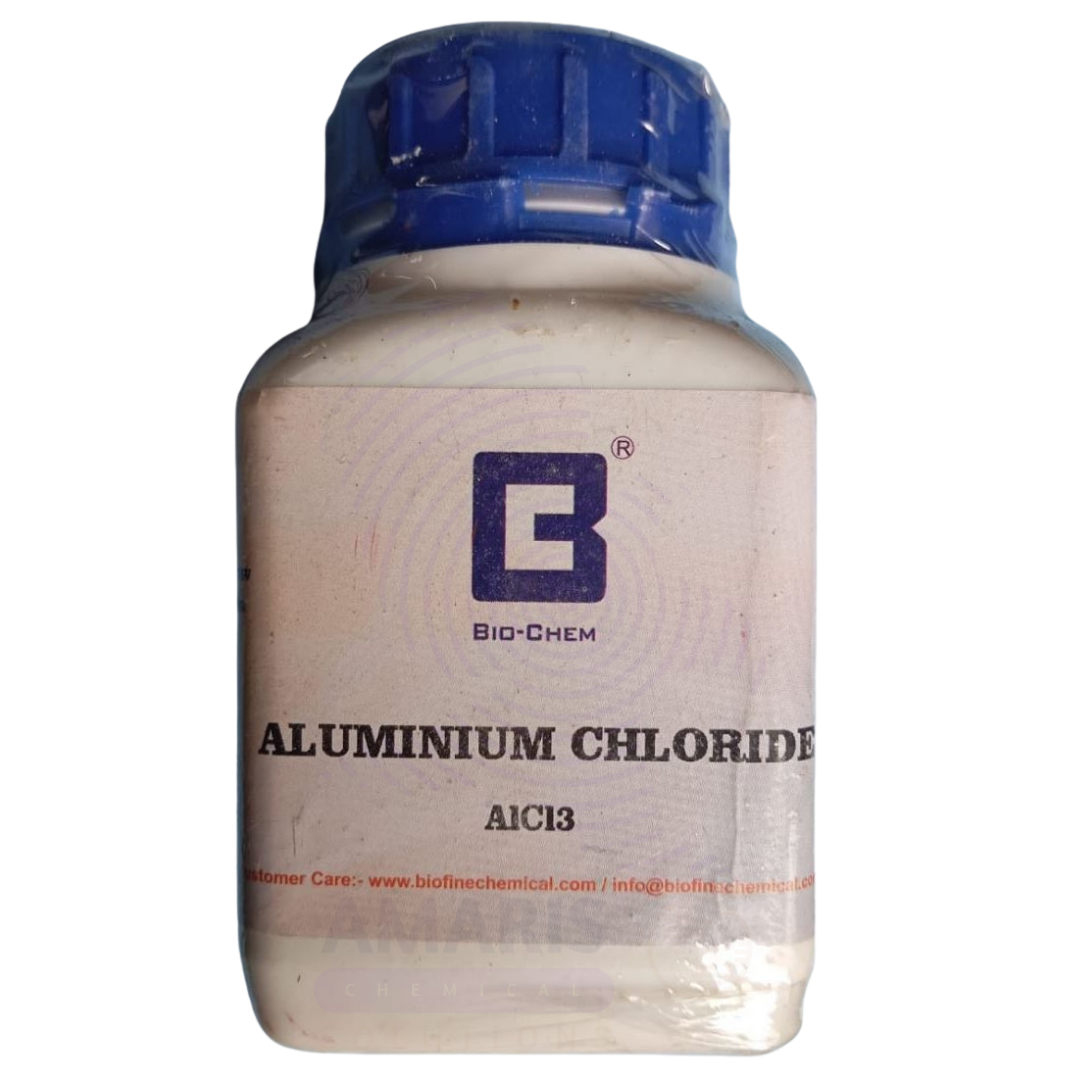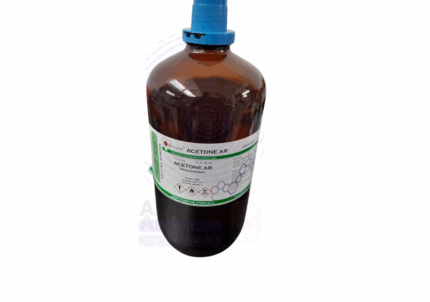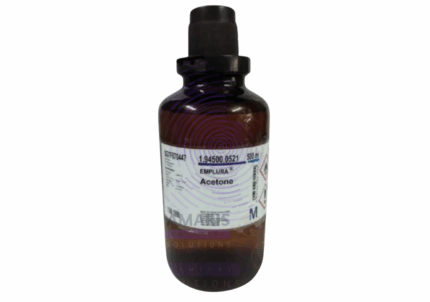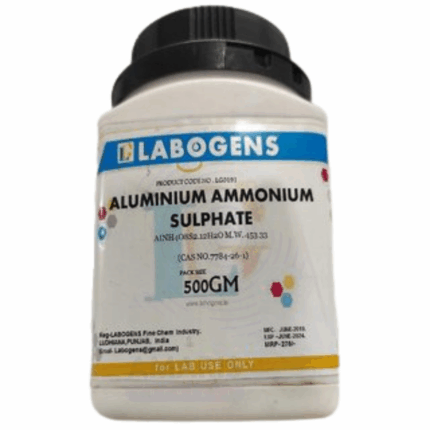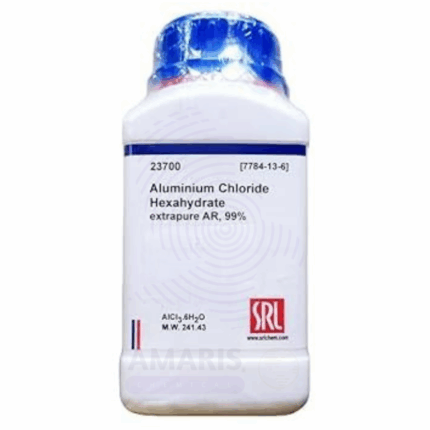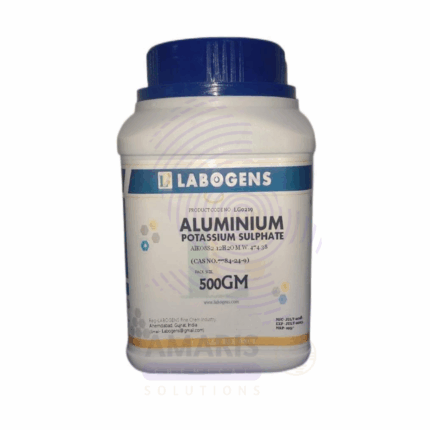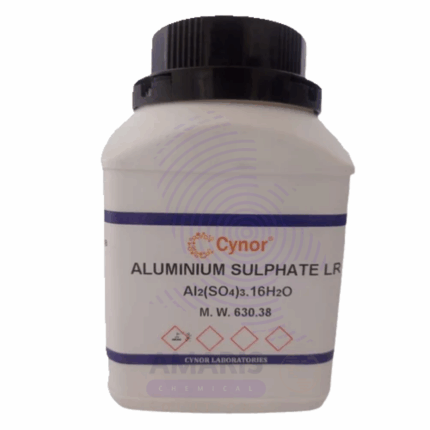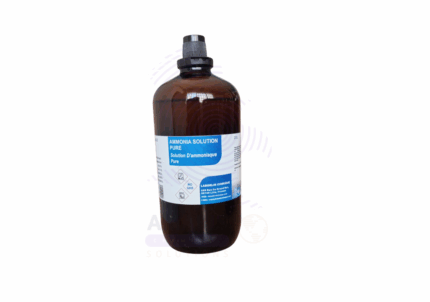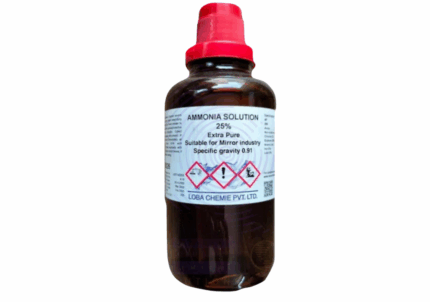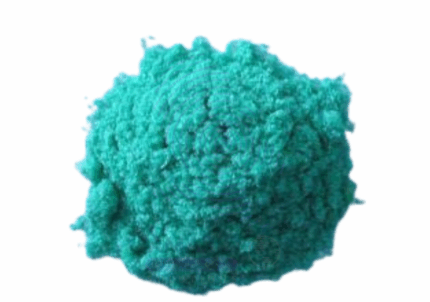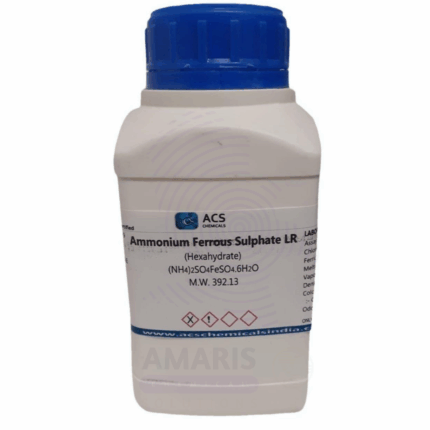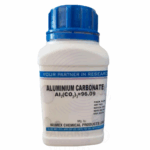
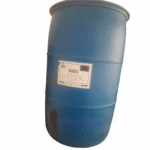
Aluminium Chloride Anhydrous Extra Pure
$ 25.00 Original price was: $ 25.00.$ 24.54Current price is: $ 24.54.
Aluminium Chloride Anhydrous Extra Pure is a high-purity, white to yellowish crystalline compound that is highly hygroscopic and fuming in moist air. It is extensively used in laboratory chemistry as a powerful Lewis acid catalyst, particularly in Friedel-Crafts alkylation and acylation reactions, as well as in the synthesis of organometallic compounds. Its anhydrous form ensures optimal reactivity and effectiveness in moisture-sensitive processes, including polymerization and halogenation studies. Due to its corrosive nature and tendency to react violently with water, it must be handled in a dry, controlled environment using proper safety measures. This extra pure grade is ideal for high-precision analytical and preparative procedures in organic and inorganic chemistry research.
Aluminium Chloride Anhydrous Extra Pure
Primary Uses
- Catalyst in Organic Synthesis
- Key Lewis acid in Friedel–Crafts alkylation and acylation reactions; essential in advanced organic chemistry labs.
- Reagent in Inorganic Chemistry
- Participates in coordination compound formation and serves in studying halide reactivity.
- Moisture-Sensitive Reaction Studies
- Ideal for dry, anhydrous conditions to explore moisture-sensitive synthesis or decomposition reactions.
- Educational Demonstrations of Lewis Acids
- Used to illustrate concepts of electrophilic activation, electron pair acceptance, and catalyst regeneration.
- Gas Absorption and Complexation Studies
- Interacts with ammonia, hydrogen chloride, and ethers in lab studies of acid-base and complex-forming behavior.
Secondary Uses
- Preparation of Aluminum-Based Compounds
- Used as a precursor in synthesizing other anhydrous aluminum salts or organoaluminum compounds.
- Research in Ionic Liquids and Deep Eutectic Solvents
- Forms part of advanced solvent systems for electrochemistry or green chemistry research.
- Reagent for Etching and Surface Modification
- In experimental metal etching or surface preparation, especially in material science labs.
- Study of Hygroscopic and Exothermic Reactions
- Demonstrates vigorous water-reactivity and heat release; ideal for thermodynamic and kinetic experiments.
- Gas Phase Reaction Investigations
- Used in lab-scale vapor-phase chlorination or synthesis involving volatile chlorides.
| PACK SIZE |
500 grams Plastic Tin |
|---|
1. Basic Identification Attributes
- Chemical Name: Aluminium Chloride (IUPAC: Aluminium trichloride, anhydrous)
- CAS Number: 7446-70-0
- HS Code: 28273000
- Molecular Formula: AlCl₃
- Synonyms:
- Anhydrous aluminium chloride
- Aluminium trichloride
- Trichloroaluminium
- AlCl₃ (anhydrous form only)
2. Physical & Chemical Properties
- Physical State: Solid (crystalline powder or lumps)
- Color & Odor: White to yellowish crystalline solid; pungent, acidic odor (hydrogen chloride-like in moist air)
- Boiling Point: ~180°C (sublimes)
- Melting Point: ~192.6°C
- Density/Specific Gravity: ~2.44 g/cm³
- Solubility:
- Water: Reacts violently, hydrolyzes to form hydrochloric acid and aluminium hydroxide
- Organic Solvents: Soluble in chlorinated hydrocarbons, benzene, nitrobenzene, and ether
- pH Level: Strongly acidic when hydrolyzed
- Vapor Pressure: High (sublimates easily at room temperature)
- Volatility: Sublimes readily; corrosive vapors
- Flash Point: Not flammable but releases flammable hydrogen chloride gas on contact with water
- Autoignition Temperature: Not applicable
- Viscosity: Not applicable (solid)
3. Safety & Hazard Attributes
- Hazard Class (GHS):
- Corrosive (Skin & Eye Damage, Category 1)
- Acute Toxicity (Category 4, inhalation and ingestion)
- Reacts violently with water
- NFPA Ratings:
- Health: 3
- Flammability: 1
- Reactivity: 2
- Exposure Limits:
- No OSHA PEL for AlCl₃
- ACGIH TLV (as soluble aluminium salts): 2 mg/m³ (respirable fraction)
- Reactivity:
- Reacts exothermically and violently with water and moist air
- Reacts with alcohols, amines, bases, and oxidizers
4. Storage & Handling Attributes
- Storage Conditions:
- Store under dry, inert atmosphere (e.g., nitrogen or argon)
- Keep tightly sealed in moisture-proof containers
- Incompatible Materials:
- Water/moisture, alcohols, strong oxidizers, bases
- Container Type:
- Amber-glass bottles with PTFE-lined caps or sealed metal containers
- Shelf Life & Expiration Date:
- 1–2 years if stored anhydrously in sealed conditions
- Special Handling Requirements:
- Use in a glove box or under fume hood
- Full PPE including gloves, goggles, lab coat, and face protection when handling powders
- Avoid contact with water or moisture in any form
5. Regulatory & Compliance Attributes
- Regulatory Status:
- Listed under TSCA, REACH, and other chemical inventories
- Controlled for handling and disposal in research institutions
- Transportation Restrictions:
- UN Number: UN1726
- Hazard Class: 8 (Corrosive)
- Packing Group: II
- Waste Disposal Method:
- Neutralize under controlled conditions with dilute base
- Dispose of as hazardous corrosive waste in accordance with institutional and EPA/RCRA guidelines
6. Environmental & Health Impact
- Ecotoxicity:
- Harmful to aquatic organisms in concentrated forms
- Highly acidic runoff can alter water pH
- Persistence in Environment:
- Reacts and hydrolyzes quickly; not environmentally persistent
- Carcinogenicity/Mutagenicity:
- Not classified as carcinogenic by IARC or NTP
- Biodegradability:
- Not biodegradable, but readily degrades by hydrolysis to less harmful forms
SAFETY PRECAUTIONS
- Personal Protective Equipment (PPE):
- Wear chemical-resistant gloves (e.g., nitrile or neoprene), tightly sealed goggles, a lab coat, and a face shield if risk of splashing exists.
- Use a properly functioning chemical fume hood when handling.
- Handling:
- Handle under dry, inert conditions to prevent contact with moisture or water (reacts violently with water, releasing hydrogen chloride gas).
- Avoid inhalation of dust or fumes.
- Use tools made of materials resistant to corrosion—avoid contact with metals in moist environments.
- Storage:
- Store in an airtight, moisture-proof container.
- Keep in a dry, cool, and well-ventilated chemical cabinet.
- Segregate from water, alcohols, acids, and bases.
- Hygiene Measures:
- Wash hands and face thoroughly after handling.
- Do not eat, drink, or smoke in laboratory areas.
- Clean work surfaces after use to avoid corrosion.
FIRST AID MEASURES
- Inhalation:
- Immediately move the person to fresh air.
- If breathing is difficult, administer oxygen and seek emergency medical help.
- Aluminium chloride fumes (HCl gas) can cause respiratory tract irritation or burns.
- Skin Contact:
- Immediately wash with copious amounts of water for at least 15 minutes.
- Remove contaminated clothing.
- Get medical attention if burns, redness, or irritation occurs.
- Eye Contact:
- Rinse thoroughly with water for at least 15–20 minutes.
- Hold eyelids apart during rinsing.
- Seek immediate medical attention—this substance can cause serious eye damage.
- Ingestion:
- Do not induce vomiting.
- Rinse your mouth with plenty of water.
- Give water to drink only if the person is fully conscious.
- Seek immediate medical attention due to the corrosive nature.
FIRE FIGHTING MEASURES
- Suitable Extinguishing Media:
- Use dry chemical powder or carbon dioxide (CO₂).
- Do not use water—violent reactions can occur.
- Specific Hazards:
- Not flammable, but reacts with water to produce corrosive and toxic hydrogen chloride (HCl) gas.
- May emit aluminum oxide fumes when heated.
- Protective Equipment for Firefighters:
- Use full protective gear and self-contained breathing apparatus (SCBA).
- Firefighting Instructions:
- Avoid water-based extinguishers.
- If safe, move containers away from the fire area.
- Cool surrounding fire-exposed containers with indirect water spray (without contacting the product).


 Preservatives(food)
Preservatives(food) Flavor Enhancers
Flavor Enhancers Acidulants
Acidulants Sweeteners
Sweeteners Antioxidants
Antioxidants Colorants(food)
Colorants(food) Nutraceutical Ingredients (food)
Nutraceutical Ingredients (food) Nutrient Supplements
Nutrient Supplements Emulsifiers
Emulsifiers
 Collectors
Collectors Dust Suppressants
Dust Suppressants Explosives and Blasting Agents
Explosives and Blasting Agents Flocculants and Coagulants
Flocculants and Coagulants Frothers
Frothers Leaching Agents
Leaching Agents pH Modifiers
pH Modifiers Precious Metal Extraction Agents
Precious Metal Extraction Agents
 Antioxidants(plastic)
Antioxidants(plastic) Colorants (Pigments, Dyes)
Colorants (Pigments, Dyes) Fillers and Reinforcements
Fillers and Reinforcements Flame Retardants
Flame Retardants Monomers
Monomers Plasticizers
Plasticizers Polymerization Initiators
Polymerization Initiators Stabilizers (UV, Heat)
Stabilizers (UV, Heat)
 Antifoaming Agents
Antifoaming Agents Chelating Agents
Chelating Agents Coagulants and Flocculants
Coagulants and Flocculants Corrosion Inhibitors
Corrosion Inhibitors Disinfectants and Biocides
Disinfectants and Biocides Oxidizing Agents
Oxidizing Agents pH Adjusters
pH Adjusters Scale Inhibitors( water)
Scale Inhibitors( water)
 Antioxidants(cosmetic)
Antioxidants(cosmetic) Emollients
Emollients Fragrances and Essential Oils
Fragrances and Essential Oils Humectants
Humectants Preservatives
Preservatives Surfactants(cosmetic)
Surfactants(cosmetic) Thickeners
Thickeners UV Filters
UV Filters
 Fertilizers
Fertilizers Soil Conditioners
Soil Conditioners Plant Growth Regulators
Plant Growth Regulators Animal Feed Additives
Animal Feed Additives Biostimulants
Biostimulants Pesticides (Herbicides, Insecticides, Fungicides)
Pesticides (Herbicides, Insecticides, Fungicides)
 Active Pharmaceutical Ingredients (APIs)
Active Pharmaceutical Ingredients (APIs) Excipients
Excipients Solvents(pharmaceutical)
Solvents(pharmaceutical) Antibiotics
Antibiotics Antiseptics and Disinfectants
Antiseptics and Disinfectants Vaccine Adjuvants
Vaccine Adjuvants Nutraceutical Ingredients (pharmaceutical)
Nutraceutical Ingredients (pharmaceutical) Analgesics & Antipyretics
Analgesics & Antipyretics
 Analytical Reagents
Analytical Reagents Solvents(lab)
Solvents(lab) Chromatography Chemicals
Chromatography Chemicals Spectroscopy Reagents
Spectroscopy Reagents microbiology-and-cell-culture-reagents
microbiology-and-cell-culture-reagents Molecular Biology Reagents
Molecular Biology Reagents Biochemical Reagents
Biochemical Reagents Inorganic and Organic Standards
Inorganic and Organic Standards Laboratory Safety Chemicals
Laboratory Safety Chemicals Specialty Laboratory Chemicals(Special Laboratory Equipment)
Specialty Laboratory Chemicals(Special Laboratory Equipment)
 Demulsifiers
Demulsifiers Hydraulic Fracturing Fluids
Hydraulic Fracturing Fluids Scale Inhibitors(oil)
Scale Inhibitors(oil) Surfactants(oil)
Surfactants(oil) Drilling Fluids
Drilling Fluids
 Dyes and Pigments
Dyes and Pigments Bleaching Agents
Bleaching Agents Softening Agents
Softening Agents Finishing Agents
Finishing Agents Antistatic Agents
Antistatic Agents
 Admixtures
Admixtures Waterproofing Agents
Waterproofing Agents Sealants and Adhesives
Sealants and Adhesives Curing Compounds
Curing Compounds Concrete Repair Chemicals
Concrete Repair Chemicals Anti-Corrosion Coatings
Anti-Corrosion Coatings
 Surfactants(cleaning)
Surfactants(cleaning) Builders
Builders Enzymes
Enzymes Solvents (Cleaning)
Solvents (Cleaning) Fragrances
Fragrances
 Electronic Chemicals
Electronic Chemicals Catalysts
Catalysts Lubricants
Lubricants Photographic Chemicals
Photographic Chemicals Refrigerants
Refrigerants Automotive chemicals
Automotive chemicals Pyrotechnic Chemicals
Pyrotechnic Chemicals
 Biodegradable Surfactants
Biodegradable Surfactants Bio-based Solvents
Bio-based Solvents Renewable Polymers
Renewable Polymers Carbon Capture Chemicals
Carbon Capture Chemicals Wastewater Treatment Chemicals
Wastewater Treatment Chemicals
 Pigments
Pigments Solvents(paint)
Solvents(paint) Specialty Coatings
Specialty Coatings Binders/Resins
Binders/Resins Additives
Additives Driers
Driers Anti-Corrosion Agents
Anti-Corrosion Agents Functional Coatings
Functional Coatings Application-Specific Coatings
Application-Specific Coatings
 Fresh Herbs
Fresh Herbs Ground Spices
Ground Spices Whole Spices
Whole Spices Spice Blends
Spice Blends Dried Herbs
Dried Herbs
 Leavening Agents
Leavening Agents Dough Conditioners
Dough Conditioners Flour Treatments
Flour Treatments Fat Replacers
Fat Replacers Decoratives
Decoratives Preservatives(baking)
Preservatives(baking)
 Plasticizers & Softeners
Plasticizers & Softeners Reinforcing Agents
Reinforcing Agents Adhesion Promoters
Adhesion Promoters Vulcanizing Agents
Vulcanizing Agents Antidegradants
Antidegradants Blowing Agents
Blowing Agents Fillers & Extenders
Fillers & Extenders Accelerators & Retarders
Accelerators & Retarders